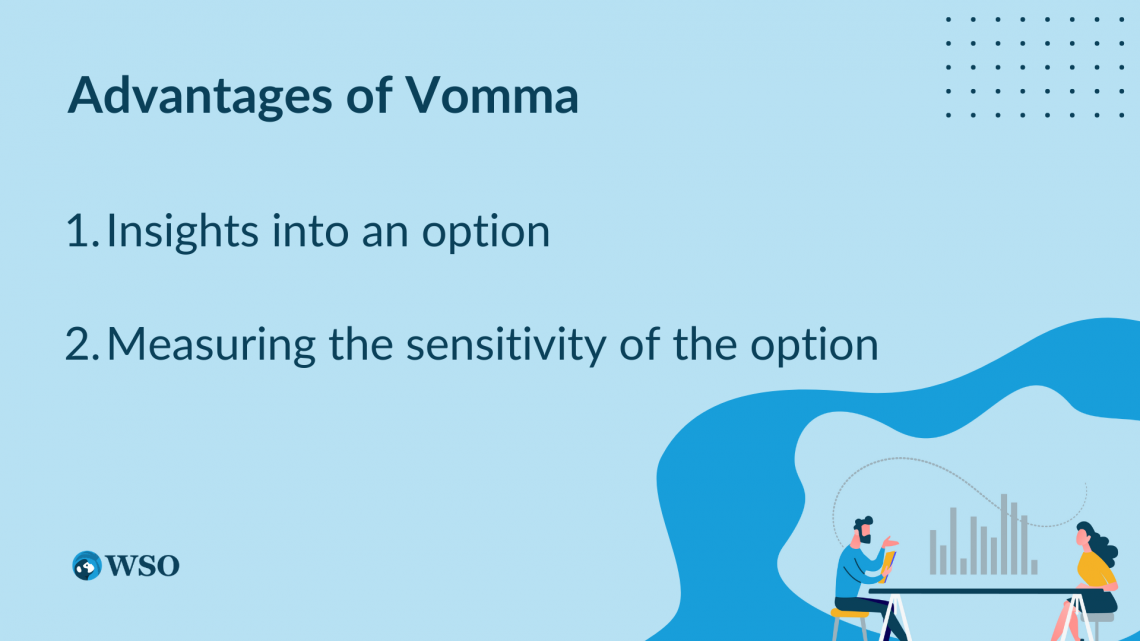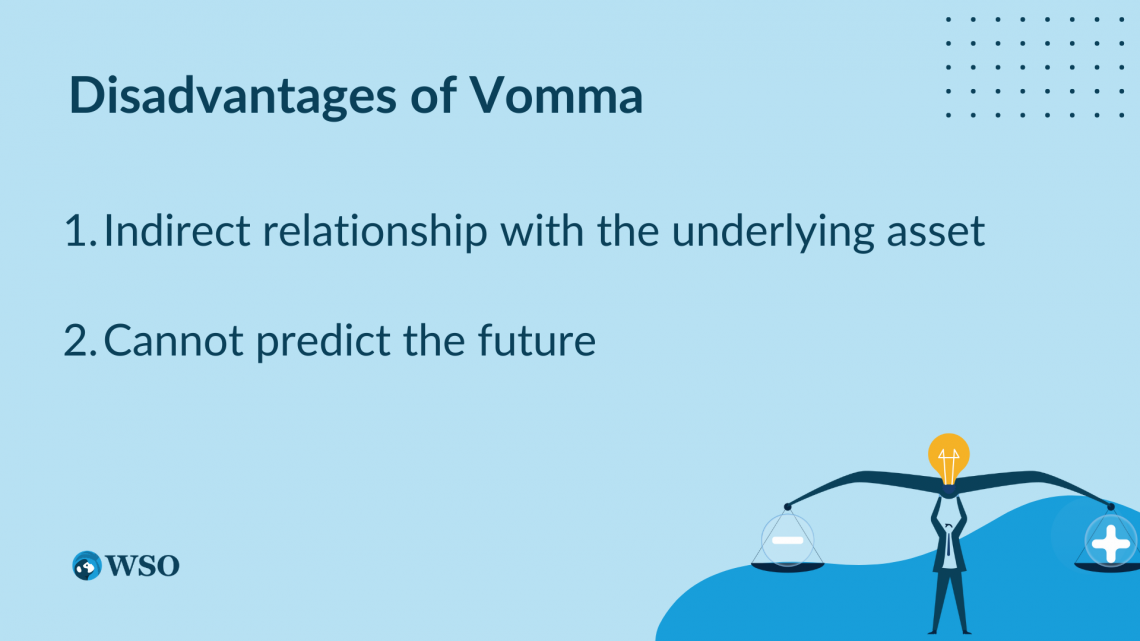Vomma
Vomma's primary utility is detecting the rate at which an option's Vega reacts to market fluctuations.
What is Vomma?
Vomma or Volatility Gamma is among many option Greeks, a second-order derivative of the option Greek Vega. Vomma's primary utility is detecting the rate at which an option's Vega reacts to market fluctuations.

It depicts the convexity or the relationship between the option prices and market changes of the Vega with the option.
The group of Greek options that the vomma is a part of is delta, gamma, theta, Vega, and Rho. We will also know about these very briefly.
Delta, in the Greek options, measures any shift in the price or the premium of an option occurring due to any changes in the underlying price of the futures. A percentage measure depicts it.
It is to be noted that the delta is positive for the call options and negative for the put options.
Coming to gamma, it measures the sensitivity of the option's delta. More accurately, the gamma lets us know the fluctuation in the delta of an option if the underlying price fluctuates by 1 unit of the currency it is dealt in.
Theta is the rate that measures the rate at which we get to know how much value the option has lost with its expiration date approaching.
Vega, as is directly related to vomma, is used to measure the change in volatility of an option point by point. In common parlance, traders mention the Vega as an option without the decimals.
The last important Greek option, Rho, is the measure of the option price's sensitivity against the interest's risk-free rate.
After getting a brief about these option Greeks, we will learn more about the vomma of an option.
Key Takeaways
- Vomma, also called Volga or Volatility Gamma, is one among many options Greeks, a second-order derivative, which is used to detect the rate at which the Vega of an option reacts to any fluctuations in the market.
- Vega, as is directly related to vomma, is used to measure the change in volatility of an option point by point.
- The sign of the vomma tells about its nature. For example, if it is positive for an option, it says that the option value will increase with an increase of a point in the percentage of the volatility of the option.
- The BSM, or the Black Scholes Model, is one of the simplest and most prominent models used in options pricing today.
- A BSM model requires five pieces of information regarding the option, namely strike price, spot price, the expiration date of the option being studied, the risk-free rate, and the volatility of the option.
Understanding the Vomma
It is the second derivative to demonstrate the value of an option, and it also depicts the relationship between the price of the option and the changes happening in the market.

The sign of the vomma is crucial to conclude the convexity of the option value. If it is positive for an option, it says that the option value will increase with an increase of a point in the percentage of the volatility of the option.
Here, vega and vomma play equally important roles in understanding how the options trade. Collectively, they both tell a lot about the option's price and its perceptiveness toward market changes.
Vomma renders important information regarding the option value being studied and its fluctuations by the underlying asset's implied volatility.
Note
Implied volatility is the movement of an option's price or value concerning any expected changes in the market. Investors and traders often use it to predict changes in future volatility of market conditions.
- If there is less volatility in the market, that means if it comes out as positive, the Vega of the option will increase.
- If the market volatility turns out to be less, that means it comes out as negative, and the Vega is decreased for the option.
Investors and traders dealing in call options should seek out its positive value. Whereas those dealing in the pit options should seek out the negative value of vomma.
It can be calculated through the following formula:
Vomma = (∂v)/(∂σ) = (∂2*V)/(∂*σ2)
However, before calculating the vomma, we need to calculate the Vega of the option.
Vega = Sϕ(d1)t1/2
Where,
ϕ(d1) = (e-(d1xd1)/2)/ (2π)1/2
d1 = [ln(S/K) + (r +(σ2/2))t]/ σ(t)1/2
Here,
- K = Strike price of the option
- S = Spot price of the option
- r = risk-free rate of interest
- σ = volatility of the underlying asset
- t = time till the option expires
Having known that, let us look into the relationship between Vega and Vomma in detail.
Relationship Between Vega and Vomma and Black Scholes Model
Now let us first know a little bit about the BSM or the Black Scholes Model. It is one of the simplest and most prominent models used in options pricing today.

BSM was developed in 1973 by Fisher Black, Robert Merton, and Myron Scholes, and it has not lost its vitality in terms of its popularity in the world of options.
It helps an investor calculate the changes in the price of the option over time with its expiration date due, changes in the underlying asset of the option, and price changes according to the market volatility.
The easy applicability of the model makes it the most useful tool in studying options today. A BSM model requires five pieces of information regarding the option. They are:
- Strike price
- Spot price
- Expiration date
- Risk-free rate
- Volatility
Even though the BSM model is the most used worldwide by many traders and analysts, it may show results that deviate from real-world outcomes, as predictions could never be fully accurate.
It still provides the best possible results for the same and helps an investor be sure about their strategy to make an informed decision.
We just read about the option Greeks in the first section. Among them, there were two very closely related Greeks:
- Vega
- Vomma

We know that Vega is directly related to vomma and is used to measure the change in the plausible volatility of an option point by point and Vomma is the second derivative of Vega.
As stated earlier, the sign of the vomma is a very important factor that helps us reach the conclusion about the convexity of the option value.
If it is positive, the option value will increase with an increase of a point in the percentage of the volatility of the option and vice versa if it turns out to be negative.
Just like Vega has a linear relationship with the options prices, Vomma uses its convexity to study about the options.
Investors use the combination of these two Greeks to determine the volatility of the option prices in accordance with various factors that may affect the option price in the coming times.
Even though the BSM model is the most used worldwide by many traders and analysts, it may show results that deviate from real-world outcomes, as predictions could never be fully accurate.
It still provides the best possible results for the same and helps an investor be sure about their strategy to make an informed decision.
Advantages and Disadvantages of Vomma
Vomma, however useful it is in the daily investing world, poses some pros and cons. Let us look into its various advantages in option price analyses.

1. Insights into an option
It is helpful for traders in predicting future changes in the prices of the options. It is the best possible prediction of the threats or probable gains from the option one trades in.
Thus, monitoring the vomma of an option constantly can help an investor get a crucial insight into their possible future gains or losses.
2. Measuring the sensitivity of the option
It is also helpful in calculating the sensitivity of the options and their price, along with the sensitivity of the option's underlying asset concerning market conditions.
This indicates to the traders the right time to buy or sell the options to gain a significant amount.
It comes most handy to the hedgers in formulating a hedging strategy to bag maximum gains from trading the options. By gaining knowledge of the sensitivity of the options, hedgers can form strategies that would fit best according to the parameters calculated regarding the option.
Despite its popularity and being the best and easiest way to analyze option pricing, it has some limitations. Now, let us look into its limitations briefly.

1. Indirect relationship with the underlying asset
When vomma is calculated, it does not consider the underlying asset directly. It explains more about the sensitivity of the Vega calculated earlier.
Even if it somehow incorporates a small unit of impact on the underlying asset, it cannot truly judge the relationship between the option price and the underlying asset as it does not depict the actual movement of the underlying asset.
2. Cannot predict the future
It cannot incorporate any unusual activities that may occur in the market in the future.
Along similar lines, vomma is not useful for judging options values long-term as the price could change drastically over a longer period.
Despite these limitations, vomma, along with other options Greeks, still provides the best possible prediction of the fluctuations of an option.
Vomma FAQs

A European-style option could be exercised only on the expiration date, whereas the American option can be exercised anytime before the expiration date.
Vomma is the second-order derivative of the Vega that measures the sensitivity of the relationship between the options prices and the market changes occurring at a time.
Collectively, they both tell a lot about the option's price and its perceptiveness toward market changes
BSM is the Black Scholes Model, the most used mathematical method of determining option pricing parameters. Investors and traders use this method the most out of all due to its easy structure and almost accurate predictions, though never completely correct.
In this article, we used the BSM model to draw a relationship between vomma or Volga and Vega which are closely related to each other through this model.
It helps traders make informed decisions regarding selling and buying financial instruments.
No, the BSM method, however popular and easy to use daily, cannot provide a holistic analysis of an option. This model is the best approximation that could help an investor or a trader make the best possible and informative decision regarding buying and selling financial security.
Thus, it cannot inhibit all the factors influencing an option but can provide the best predictions about the traded options.
Vanna is also a part of options Greeks which measures the fluctuations of the delta, another option Greek, with respect to the implied volatility. Implied volatility, as explained earlier, is the movement of an option's price or value concerning any expected changes in the market.
Along with being related to delta, it can also be associated with Vega as it indicates the changes in Vega occurring due to small changes in the underlying asset's price.
An ITM or 'In the money' is when an option has an intrinsic value, and the difference between its market price and the strike price can be deployed to earn profits.
Whereas an OTM or 'Out of the money' is when an option has an intrinsic value, and the difference between its market price and the strike price poses a possibility of losses.
Coming to the ATM or 'At-the-money' call option means that the option's strike price of the particular underlying asset is equal to the prevailing market price. Therefore, no gain and no loss.
Researched and authored by Anushka Raj Sonkar | Linkedin
Free Resources
To continue learning and advancing your career, check out these additional helpful WSO resources:




or Want to Sign up with your social account?